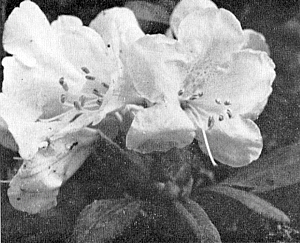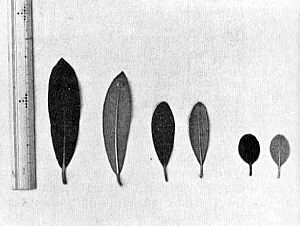A New Rhododendron Found in Japan
Hideo Suzuki. Saitama-Ken, Japan

|

|
|
FIG. 50. The pink buds of R. x kurohimense
turn white with pink nerves on the outside of the corolla as the florets open. Photo by Hideo Suzuki |
FIG. 51. Leaves of R. x
kurohimense
(center)
found on Mt. Kurohime in Japan are midway in size and shape between the leaves of its parents R. degronianum (left) and R. chrysanthum . The ruler is in metric scale. Photo by Hideo Suzuki |
In 1970 a stand of a new Rhododendron was discovered on Mt. Kurohime in the northern part of Nagano Prefecture, Central Japan. The description by the discoverer, K. Arakawa of the same prefecture, is as follows:
"Ecologically it is a member of the shrubbery standing on the rocky slope of tuff at about 1850 meters (5500 feet) in elevation, which consists of some alpine plants such as
Pinus pumila
,
Empetrum nigrum
var.
japonicum
,
Rhododendron chrysanthum
,
R. brachycarpum
,
R. niko-montanum
, and also some subalpine ones such as
Tsuga diversifolia
,
Thuja standishii
and
Rhododendron degronianum
. Morphologically, it is characterized by procumbent stems, persistent scales of the bud, and impressinerved leaves above like
R. chrysanthum
and by pinkish and funnel-shaped flowers like
R. degronianum.
The hairiness of its leaves beneath and the size of them are intermediate between these two species."
Judging from these facts, K. Arakawa recognized it to be a natural hybrid between
R. chrysanthum
and
R. degronianum
. It was named R. x
kurohimense
Arakawa and is now commonly called the "Kurohima Shaku Nage" (rhododendron).
The flower is entirely pinkish when in bud and turns whitish with pinkish nerves outside. The size of the leaves is exactly between the size of the parent's leaves, as shown in the center of Fig. No. 51. The largest leaves in the picture are
R. degronianum
and the smallest ones are
R. chrysanthum
.
Usually
R. degronianum
and
R. chrysanthum
grow at different elevations and the flowering times also differ by about two weeks. Under such circumstances, natural hybridization between them is not at all possible. The interesting thing, however, is that at 1850 meters in elevation on Mt. Kurohime where the new Rhododendron was discovered they grow in the same shrubbery stand and their flowering times exactly correspond! The reason why such a high elevation grower as
R. chrysanthum
inhabits such a low elevation is said to be due probably to the coolness created by the air current blown through many wind holes scattered among the lava rocks.
Note: Academically, it is an established theory that
R. nikomontanum
is another natural hybrid between
R. brachycarpum
and
R. chrysanthum
.
There has been much argument about whether this was possible because of the difference between their flowering periods. I have been one of those who doubted. However, I now feel positive that it is true, judging by a report by K. Arakawa which I am not introducing at this time.